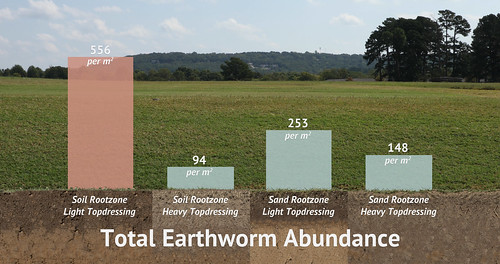Just in time for spring: Video summarizes much-needed earthworm management research for turfgrass industry
April 4, 2018
By Mary Hightower
U of A System Division of Agriculture
Fast facts:
- Video summarizes research examining sand topdressing strategies
- Video can be found here: https://youtu.be/AZbVKtd9MsU
(105 words)
(Newsrooms – with downloadable art at www.flickr.com/photos/uacescomm/albums/72157682791992112)
Download Word version
FAYETTEVILLE, Ark. – Earthworms are an important part of soil health, but their habit of pooping on the soil surface, commonly called casting, has made them a difficult-to-manage nemesis to golf course superintendents charged with keeping greens and fairways smooth and playable.

“While managing earthworms is a common issue for golf course superintendents, it hasn’t been studied much,” said Mike Richardson, professor-horticulture and turfgrass expert with the University of Arkansas System Division of Agriculture and the Bumpers College of Agricultural Food and Life Sciences. “Which means there’s somewhat of a vacuum of best management practices in this area.”
However, Paige Boyle made this conundrum the subject of her graduate studies at the University of Arkansas, examining how sand topdressing affects worm cast, or vermicast, production. She’s now continuing her ecological studies with a Presidential Dissertation Research Fellowship at Utah State.
Her Arkansas findings are documented in a new video produced by the University of Arkansas System Division of Agriculture, with support from the United States Golf Association: https://youtu.be/AZbVKtd9MsU.
“Paige’s work has been well-received by the golf course industry as it provides clues to solutions where there hadn’t been any,” Richardson said. “This video neatly summarizes her findings just in time for spring turf management routines.”
For more information about horticulture, contact your county extension office or visit www.uaex.uada.edu or http://horticulture.uark.edu/about-us/focus-areas.php.
About the Division of Agriculture
The University of Arkansas System Division of Agriculture’s mission is to strengthen agriculture, communities, and families by connecting trusted research to the adoption of best practices. Through the Agricultural Experiment Station and the Cooperative Extension Service, the Division of Agriculture conducts research and extension work within the nation’s historic land grant education system.
The Division of Agriculture is one of 20 entities within the University of Arkansas System. It has offices in all 75 counties in Arkansas and faculty on five system campuses.
Pursuant to 7 CFR § 15.3, the University of Arkansas System Division of Agriculture offers all its Extension and Research programs and services (including employment) without regard to race, color, sex, national origin, religion, age, disability, marital or veteran status, genetic information, sexual preference, pregnancy or any other legally protected status, and is an equal opportunity institution.
# # #
Media Contact: Mary Hightower
Dir. of Communication Services
U of A System Division of Agriculture
Cooperative Extension Service
(501) 671-2126
mhightower@uada.edu